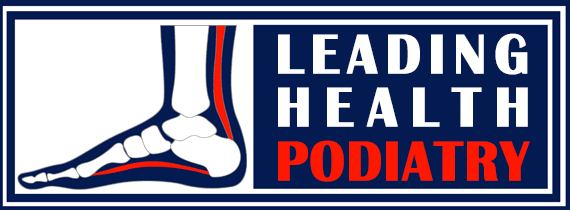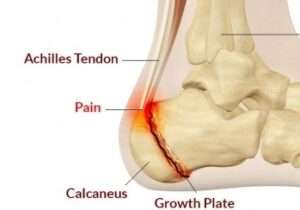Heel Pain in Kids | Sever’s Disease
What is Heel Pain in Kids?
Heel pain is a common complaint among children, particularly those who are active in sports or physical activities. One of the leading causes of heel pain in kids is a condition called Sever’s Disease, which typically affects children aged 8 to 14 years. This condition is often linked to growth spurts, where the bones grow faster than the muscles and tendons, causing discomfort and inflammation in the heel area.
What is Sever’s Disease?
Sever’s Disease, or calcaneal apophysitis, occurs when the growth plate in the heel becomes irritated due to repetitive stress or overuse. The growth plate is the area of soft cartilage where the heel bone is still growing, and it can become inflamed from excessive pressure during physical activities. Sever’s Disease is most common in active children, particularly those involved in running, jumping, or sports like soccer, basketball, and gymnastics.

Symptoms of Sever’s Disease (Heel Pain in Kids)
Children with Sever’s Disease often experience:
- Heel pain at the back of the heel, especially after physical activities.
- Swelling and tenderness around the heel or the Achilles tendon.
- Pain that worsens with exercise or after long periods of walking, running, or jumping.
- Stiffness in the heel, especially in the morning or after rest.
- Complaints of limping or walking with discomfort.
It’s important to note that Sever’s Disease typically affects both feet, but one side may be more painful than the other.
Causes of Sever’s Disease
Several factors contribute to the development of Sever’s Disease:
- Rapid Growth Spurts: Children’s bones grow faster than the muscles and tendons, which can lead to tightness and increased strain on the heel.
- Repetitive Physical Activity: Activities that involve running, jumping, or sudden changes in direction can place repeated stress on the heel.
- Improper Footwear: Shoes without adequate cushioning or support can exacerbate heel pain and contribute to the development of Sever’s Disease.
- Flat Feet or High Arches: Foot posture issues can increase strain on the heel and make it more susceptible to injury.
How We Treat Heel Pain in Kids (Sever’s Disease) at Leading Health Podiatry
At Leading Health Podiatry, we understand how frustrating heel pain can be for children, especially when it affects their ability to play and be active. Our team of experienced podiatrists provides comprehensive treatment to help manage Sever’s Disease and get kids back on their feet without pain.
Accurate Diagnosis: Our podiatrists conduct a thorough assessment, including physical examination and diagnostic imaging if necessary, to confirm that Sever’s Disease is the cause of your child’s heel pain.
Rest and Activity Modification: Depending on the severity of the condition, we may recommend reducing high-impact activities or taking breaks from sports to give the heel time to heal. Activity modifications can help prevent further irritation and allow the growth plate to recover.
Stretching and Strengthening Exercises: We teach children specific exercises to stretch the calf muscles and Achilles tendon, as well as strengthen the muscles around the foot and ankle. This helps to reduce stress on the heel and improve flexibility.
Footwear Advice: Proper footwear is essential for managing Sever’s Disease. Our team can advise on selecting shoes that provide adequate support, cushioning, and stability for your child’s feet. In some cases, we may recommend custom orthotics to improve foot posture and alleviate pressure on the heel.
Ice and Anti-Inflammatory Treatment: Ice therapy can help reduce inflammation and provide relief from pain. In some cases, we may suggest over-the-counter anti-inflammatory medications to manage pain and swelling.
Heel Cushions and Padding: To reduce pressure on the heel, we may recommend using heel cups or pads that fit inside the shoes to provide extra cushioning and comfort during activities.
Taping or Strapping: We may use taping techniques to provide support to the heel and reduce strain on the affected area. This can help your child continue to engage in light activities without further aggravating the condition.
- Custom Orthotics: Custom orthotics are personalised insoles that we design to fit your child’s feet perfectly. These orthotics provide additional support, cushioning, and alignment for the feet, helping to reduce strain on the heel and correct any foot posture issues that may be contributing to pain. Custom orthotics can play a crucial role in treating Sever’s Disease and preventing future episodes of heel pain.
Monitoring and Follow-Up Care: We provide ongoing monitoring to track your child’s progress and adjust the treatment plan as needed. Regular follow-up appointments ensure that your child is on the path to recovery and able to return to normal activities without pain.
When to Seek Help for Heel Pain in Kids
If your child is experiencing persistent heel pain, particularly after activity or exercise, it’s important to seek professional help. Early diagnosis and treatment can help prevent the condition from worsening and improve your child’s quality of life.
Why Choose Leading Health Podiatry for Sever’s Disease Treatment?
At Leading Health Podiatry, we have extensive experience in treating heel pain in children, including Sever’s Disease. Our team provides personalised, evidence-based care to help your child recover quickly and safely. We are dedicated to offering the best possible treatments to ensure your child’s feet stay healthy and pain-free.
Contact Leading Health Podiatry Today
If your child is experiencing heel pain or signs of Sever’s Disease, don’t wait for the condition to worsen. Contact Leading Health Podiatry today for a comprehensive assessment and effective treatment options tailored to your child’s needs.

